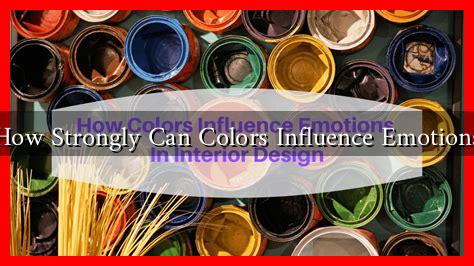-
Table of Contents
How Strongly Can Colors Influence Emotions?
Colors are an integral part of our daily lives, influencing our moods, perceptions, and even behaviors. From the vibrant hues of a sunset to the calming shades of a hospital room, colors evoke a spectrum of emotions. This article delves into the psychological effects of colors, exploring how they can shape our feelings and reactions in various contexts.
The Psychology of Color
The study of color psychology examines how colors affect human behavior and emotions. Different colors can elicit specific feelings and associations, often rooted in cultural and personal experiences. Here are some common emotional associations with colors:
- Red: Often associated with passion, love, and anger. It can increase heart rates and evoke strong emotions.
- Blue: Typically linked to calmness, trust, and sadness. It is often used in corporate branding to convey reliability.
- Yellow: Represents happiness, optimism, and energy. However, excessive yellow can lead to feelings of frustration.
- Green: Symbolizes nature, growth, and tranquility. It is often used in spaces designed for relaxation.
- Purple: Associated with luxury, creativity, and spirituality. It can inspire imagination and introspection.
Case Studies and Real-World Applications
Numerous studies have demonstrated the impact of color on emotions. For instance, a study published in the journal *Color Research and Application* found that individuals exposed to red light reported higher levels of excitement compared to those in blue light. This finding has significant implications for marketing and design.
In the realm of marketing, brands often use color strategically to influence consumer behavior. For example:
- McDonald’s: The use of red and yellow in their branding is designed to stimulate appetite and create a sense of urgency.
- Facebook: The blue color scheme is intended to evoke feelings of trust and security, encouraging users to engage with the platform.
- Starbucks: The green logo represents growth and sustainability, appealing to environmentally conscious consumers.
Moreover, color can significantly impact workplace productivity and employee well-being. A study by the University of Texas found that employees in blue offices reported higher levels of creativity, while those in red offices performed better on detail-oriented tasks. This suggests that the choice of color in office design can enhance both creativity and efficiency.
Color in Therapy and Healing
Color therapy, or chromotherapy, is a holistic treatment that uses colors to promote healing and emotional well-being. Practitioners believe that different colors can influence energy levels and emotional states. For example:
- Blue light therapy: Used to treat seasonal affective disorder (SAD), helping to alleviate symptoms of depression.
- Red light therapy: Often used for pain relief and to promote healing in physical therapy settings.
- Green light therapy: Associated with reducing anxiety and promoting relaxation.
While scientific evidence supporting color therapy is still emerging, many individuals report positive experiences and emotional relief through these practices.
Conclusion: The Power of Color
Colors have a profound impact on our emotions and behaviors, influencing everything from marketing strategies to workplace productivity and therapeutic practices. Understanding the psychological effects of colors can empower individuals and organizations to create environments that foster positive emotional responses.
As we navigate a world rich in color, it is essential to recognize the power these hues hold over our feelings and interactions. Whether you are designing a space, crafting a marketing campaign, or seeking emotional healing, consider the colors you choose and the emotions they may evoke.
For further reading on the psychology of color, you can explore resources like the Color Psychology website, which offers insights into how colors affect our daily lives.


